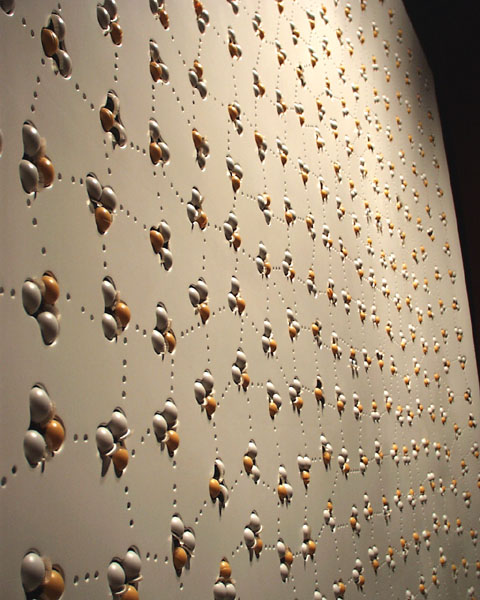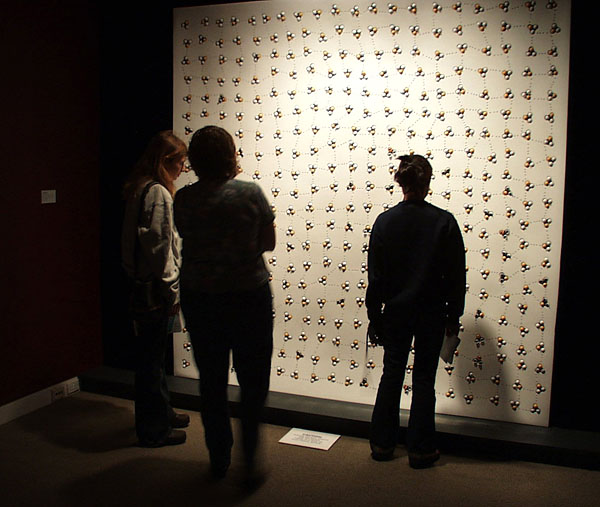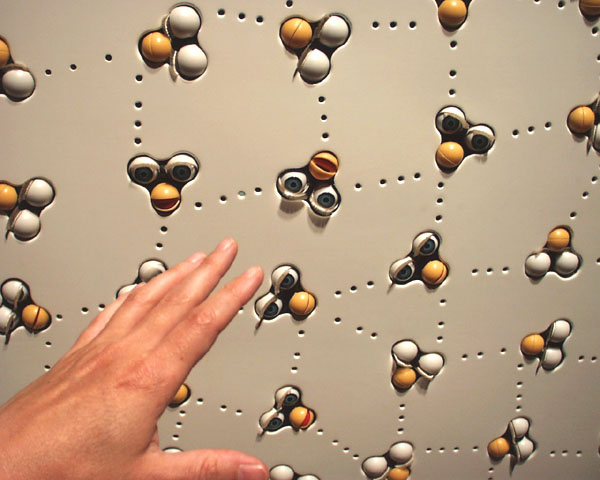Phaedra Shanbaum
The aim of this article is twofold: It is a reflection on theories about art and technology in the last decade. The concepts explored are drawn from scholars in varying disciplines (media studies, computer sciences, art history) but who identify, despite their methodological differences, with a particular concept of technology. On the other hand, it tries to clarify issues – specifically issues around the so-called disappearance the digital interface, in interactive artworks– that is beginning to provoke discussion in the aforementioned fields. (1) This article has no pretense of being an exhaustive theoretical or methodological study on this subject. What follows then should be seen as an account of the concepts of ubiquitous computing and cybernetics as they apply to new media art. The first part of this account will present a brief overview of the notion of ubiquitous computing. This will provide background into the critique in the second section of some of the dominant scientific and cultural narratives that surround ubiquitous computing, specifically cybernetics and the notions of symmetry, asymmetry, agency and the binary subject/object distinction.
In his article, “The Computer for the 21st Century” (1991), computer scientist Mark Weiser details a new model of Human to Computer Interaction (HCI): ubiquitous computing. (2) Ubiquitous computing refers to spaces in which technology is seamlessly integrated into every object, building and human body, thus creating environments, objects and bodies that are completely saturated with technology and wireless networked devices. Weiser argues that this integration creates “a new kind of relationship of people to computers, one in which the computer would have to take the lead in becoming vastly better at getting out of the way, allowing people to just go about their lives.” (3) He continues by arguing that changing the predominant, unsatisfactory models for interacting with digital information and focusing the user’s attention away from the ‘single black-box’, allows technology to “vanish into the background.” (4) In other words, Weiser believes that ubiquitous computing has the potential to alter the HCI paradigm, through the integration of multiple computational devices into the environment. This would ultimately focus the users’ attention away from the functions and capabilities of the device, allowing them to concentrate on other more “important” tasks. (5)
The importance of Weiser’s theories surrounding ubiquitous computing in my opinion, however, is not that technology has become a more integrated tool, although this attribute is essential to understanding this type of technology. The significance lies in Weiser’s contention that the issues, such as the use of the outdated models to describe HCI or the way the relationship between the body and technology is described, are not unique to a particular type of technology or a specific field of study. These problems relate to wider issues about what technology is, what it does and how it is utilized. Thus they re-frame debates about the traditional conceptions of computation, interaction and aesthetics as both technical engineering issues and as socio-cultural problems.
A Case in Point:
To begin to unravel some of the importance of these debates and theories I will turn to new media artist Kelly Heaton’s installation The Pool (2000-2001). The Pool consists of a 90” X 90” custom-designed wall. (6) Embedded into the wall are four hundred toy robots called Furbys. (7) (FIGURE 1) The Furbys, in this work, have been modified from their original state. Heaton has stripped them of their plush coverings and wired them together. She has then encased them in the wall so that only their “eyes” and “beaks” are visible to the viewers. (FIGURE 2) (8)
 Figure I
Figure I
 Figure 2
Figure 2
Subjected to manipulation, each Furby is chopped-up, gutted, reconfigured and they assume multiple new identities: a molecule, a specimen, a pixel, a subject, and an object. Heaton has literally dissected both the conceptual idea of “The Furby” and the physical Furby itself, and corporeally transformed it, using its various parts to engender new hybrid forms and artistic deployments of technology.
The Pool then explores notions about what technology is, or could be, and by doing this I posit that it also reconfigures technical issues around ubiquitous computing as a cultural source of uncertainty and potentiality. Although Heaton’s deployment of technology challenges us to critically think about notions like singularity (of technology) and separation (of the object and the subject) in new media art both the artwork and the technology used have roots in cybernetics.
Coined by mathematician Norbert Wiener in 1965, cybernetics is a term that characterizes a “very general science of control and communication in the animal and the machine.” (9) Cybernetics is a way to regulate machine-based systems by measuring their actual performance in real-time and feeding the results back into the machine, creating a continual feedback loop. The purpose of this feedback loop according to Wiener, is “to control the mechanical tendency towards disorganization; in other words, to produce a temporary and local reversal of the normal direction of entropy.” (10) Cybernetics, to Wiener, then is a way of organizing, and to a certain extent controlling, “modern liberal humanism” as well as modern behaviors, culture and society. (11)
Media theorist N. Katherine Hayles (1999) critiques Wiener’s notion of cybernetics. She argues that the premise of Wiener’s cybernetic feedback loop disembodies the human subject. It creates borders between humans and nonhumans, exposing, among other things an oppressive Cartesianism, thus, undermining Wiener’s notions of liberal humanism. (12) As she writes: “When the physical boundaries of the human form are secure, he [Wiener] celebrates the flow of information through the organism. All this changes, however, when the boundaries cease to define an autonomous self, either through manipulation or engulfment.” (13) These problems occur because similar to ubiquitous computing, the science of cybernetics, as Søren Brier (2008) states, “focuses not on being but on behavior: it does not ask, ‘what is this thing?’ but instead, ‘what does it do?’ Or how can we make a thing that does this?”(14) Therefore, the cybernetic and ubiquitous computing technologies developed in the past decade, are not about subjective individuals or individual consciousness as they claim to be, because these modes of thinking do not position them as self-referential or autopoietic. (15) The entities studied, as Brier argues are “all allopoietic that is, created and made by something else, some other system.”(16)
Echoing Brier, Hayles and Wiener’s theories and building on them, Søren Bro Pold (2011) suggests that a cybernetic artwork is a form that is: “constructed through a remediation of older representational forms…complete with their various traditions, genres and media characteristics.” (17) However, this form, Pold argues, also incorporates cybernetic feedback and interaction, in the sense that it allows the viewer to: “interact with its representations and it registers the user and his/her interactions through input devices, sensors and tracking.” (18) Therefore, a cybernetic artwork to Pold is a form that simultaneously builds on and incorporates “media history and aesthetic traditions of how to represent things in a way that are distinguishable and meaningful to human perception” and a computerized mechanism that contains “an action-reaction pattern which, through sensors, input devices, tracking, data-mining and surveillance, registers the recipient and incorporates his/her responses and reactions.”(19) And in being this way, he argues, the artwork is able to construct its own perceptional and representational feedback loop. (20)
Applying these notions to The Pool, the Furbies may exist in this installation as hybrid technologies on many levels between hardware (gears, and wires), software (layers of code), human and nonhuman. While they may demonstrate how art has the potential to critically explore notions of objects and subjects, and while they can be seen as a representational medium that is used for cultural production, they are ultimately functional tools, robotic toys. That is to say, the technology used (the Furby) is a cybernetic machine that treats all of the information in the installation in generalized, statistical terms. It has no way to judge the importance the information that it is receiving and processing, such as the viewer’s movements or the meaning of their speech. However, in the specific context of The Pool, technology can also become an aesthetic form that has the ability to allow the viewer to make conscious and unconscious connections between machine, representation and culture. Thus, technology in this work and the problems associated with it are simultaneously those of technical, functional mediums and those of representational, cultural forms. And while this designation as both technical medium and cultural form is, as Pold writes, “distinctive for [technology] and its cultural potential”, it is also troublesome. (21) This is because, he states that cybernetic technologies are systems that statistically “measure and interpret” the information in the environment that they are located in, and the viewer, interacting with this technology, is always a part of this information. (22)
For instance, each Furby in The Pool, according to Heaton is “actuated by a motor to achieve two visible states open (and talking) or closed (and silent).” (23) In addition, each Furby contains a microcontroller that prompts it to “speak” in response to the proximity of the viewer. So, when the viewer enters the exhibition space, they see a large white wall covered from top to bottom with disembodied sleeping Furby faces. (FIGURE 3) As the viewer approaches the wall, a custom designed infrared detection system picks up their presence and causes the Furbys to open their eyes. If the viewer walks right up to the wall, the Furbys respond to them by opening their beaks and “speaking.” (FIGURE 4)
 Figure 3
Figure 3
 Figure 4
Figure 4
Thus, I suggest that the distinction between technology (the nonhuman) and subject (the human) becomes blurred. Blurring occurs in this particular instance because the object (the Furby) is self-referential. It has the ability to “speak.” In this way, the Furby can be perceived, by the viewer, as “intelligent” because it has displayed the elementary human like ability of speech. While this self-referential “talk” may have the potential to encourage interesting types of human-to-computer interactions, I argue that the literal human-to-machine communication in this work is problematic. This is because it creates, among other things, what I see as a highly constrained looped dialogue between the viewer and the Furby. This dialogue, when theorized in combination with the blurring of the human-machine boundary, then implies a generalized symmetry between the viewer and technology. (24)
To put it differently, although the use of ubiquitous and cybernetic technology in this work may highlight the uncertainty and potentiality that occur when objects and subjects are positioned as entangled entities, thus able to blur the lines between the human and the machine, the cybernetic character of technology, as Pold states: “pervades both the machine and the medium.” (25) Therefore, this particular deployment of technology could be read as problematic because the cybernetic functions of the Furby could be seen to influence, among other things, the viewer’s interactions with the installation and the way the subject and the object are positioned and analyzed. In this sense, the relationship between the human and technology, while active, is not co-constitutive. Rather, I argue this relationship is presented to the viewer as symmetrical. This is precisely because the blurring of the human-machine boundary (which occurs when the viewer, attempts to “talk” to the Furbys) incorporates the viewer into it. Thus the viewers become, to a certain extent, part of the cybernetic system themselves.
However, The Pool, with its dissected technology, its symmetrical subjects and objects and its self-referential, looped dialogue, could be seen as an example of an artwork that critically questions notions of equivalence, agency and erasure, exposes their flaws and then turns them back against themselves. It does this not through outright opposition, but rather through replication and parody. Therefore, I suggest that the technology used in The Pool and The Pool as an art installation does not so much act as a resistance to, but rather is a playful cybernetic criticism of a cybernetic system. Instead of arguing against a system and a mode of thinking that it is an integral and active part of, The Pool, with its fragmented interface (the cybernetic Furby) and its underlying scientific significance (the shape of its wall, the aesthetic arrangement of the Furbys and Heaton’s dual role as artist and taxidermist), could be understood as questioning the validity of, and then poking fun at this system. So, rather than expanding discussions around seamlessness or how humans retain a distinct form that is categorically different from technology, even though the two can be “interactively coupled”, as is done in ubiquitous computing theories, The Pool subversively exposes the flaws in and around these systems by parodying itself. In doing this, I argue The Pool provides the viewer with both an alternative and a means to exploit this goal-oriented technological thinking.
Phaedra Shanbaum is a contemporary arts curator and researcher from Detroit, MI, USA. She is currently a Mphil/PhD candidate at Goldsmiths College, University of London. Her research project is on new media art, focusing on the use of the interface within interactive new media art installations.
Notes:
(1) Recently published texts on this topic include, Alexander Galloway (2012), Christian Ulrik Andersen and Søren Bro Pold (2011) and Seung-Hoon Jeong (2014).
(2) Mark Weiser. “The Computer for the 21st Century”. Scientific American, September 1991.
(3) Ibid., Pg 6.
(4) Ibid., Pg 9.
(5) Ibid.,
(6) Kelly Heaton. The Pool (2001). Found online here
(7) Ibid., A Furby is an electronic robot marketed as a children’s toy in North America. Furbys are deemed “intelligent” by the company that manufactures them (Hasbro) because they have the ability to communicate or “speak” with others, open and close their “eyes” and “beaks” and move. In addition to this, each Furby can be customized and remotely controlled online by the person purchasing it for an additional fee. ( http://www.hasbro.com)
(8) Ibid.,
(9) Norbert Weiner. Cybernetics: or the control and communication in the animal and the machine. (Cambridge, MA: MIT Press, 1965). Pg 11.
(10) Ibid.,
(11) While cybernetics is developed and presented as a way to organize society in The Human Use of Human Beings Wiener backs away from this theorization, in his speech “Men, Machines, and the World About” where, he warns against worshiping machines, instead arguing for an understanding of them.
(12) N. Katherine Hayles. How We Became Posthuman. (Chicago IL: University of Chicago Press, 1999).
(13) N. Katherine Hayles. How We Became Posthuman. (Chicago IL: University of Chicago Press, 1999). Pg 107.
(14) Soren Brier. Cybernetics. (2008) Pg 89.
(15) Ibid., Autopoietic or autopoiesis according to Brier refers to: “systems such as living cells, that are self-referential in that they are self-maintaining: they are themselves the product of their own operation.” These autopoietic machines, as he states, are studied and developed in the second wave cybernetics. (Brier, 2008).
(16). Soren Bro Pold. “The Cybernetic Mentality and Its Critics: Ubermorgen.com”. in Interface Criticism: Aesthetics Beyond Buttons. ed. Christian Ulrik Andersen and Soren Bro Pold. (Arhaus, DK: Arhaus University Press, 2011). Pg 91.
(16) Ibid
(17) Ibid., Pp 91, 93
(18) Ibid., Pg 92.
(19) Ibid.,
(20) Ibid., Pg 92.
(21) Ibid., Pg 96.
(22) Ibid.,
(23) Kelly Heaton. The Pool (2001). Found online here
(24) These notions of symmetry, asymmetry and anthropomorphization, their problems and their limitations are discussed in full in Lucy Suchman’s book Human-Machine Reconfigurations: Plans and Situated Actions. (2007)
(25) Soren Bro Pold. “The Cybernetic Mentality and Its Critics: Ubermorgen.com” in Interface Criticism: Aesthetics Beyond Buttons. ed. Christian Ulrik Andersen and Soren Bro Pold. (Arhaus, DK: Arhaus University Press, 2011). Pg 97